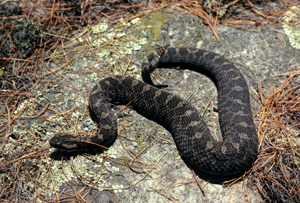Eastern Massasauga Rattlesnake
Georgian Bay Islands National Park
Yes, There Are Rattlesnakes In Georgian Bay Islands National Park!
In fact this is one of the few places you can still find an Eastern Massasauga Rattlesnake (Sistrurus catenatus) in Canada. Due to disappearing habitat and human persecution, the snake is considered threatened and listed on the Canadian Endangered Species List. Currently there is an Eastern Massasauga Rattlesnake Recovery Team, chaired by the Park Ecologist that works with the Provincial Government, Conservation Authorities, Ontario Parks and many other groups interested in the conservation of this unique and special reptile.

Eastern Massasauga Rattlesnake on Northern Beausoleil Island.
© Parks Canada/ Bill Carswell, 1977
How to tell a rattlesnake from the many other snakes in Ontario
- The rattlesnake has a blotched pattern, but so do the fox snake, water snake, milk snake and hognose snake.
- The rattlesnake tail has a rattle - it is the only one that has a rattle BUT it is NOT the only snake that will rattle - so will the milk snake, fox snake and water snake. When these other snakes rattle against dry grass or vegetation it can sound similar to a rattlesnake. The other snake's tails will appear pointed rather than blunt like the rattlesnake.
- The rattlesnake measures 47-76 cm in length with a thick body.
- The rattlesnake has a diamond shaped head - it is the only one with this head shape in this area.
- The rattlesnake has a vertical pupil - again it is the only one in this area like this. Note that you are likely too close if you can see it!
How to stay safe around Rattlesnakes
- Learn to identify snakes.
- Wear protective footwear, hiking boots and long pants.
- Do not pick up rattlesnakes or any other wild animals. This is the most frequent cause of bites.
- Watch where you put your hands and feet. Carry a flashlight at night. Check under bushes or rocks with a stick before you reach there.
- Stay calm if you see one. They will not chase you, they are timid and would prefer to leave. Determine where the snake is and give it room to move away.
- Keep your pets on a leash. Curious pets are more often the victim of bites than people.
Only two people in Eastern Canada have died from a Massasauga bite - neither received proper treatment.
What if you or a friend are bitten?
Stay calm. Although there may have been a bite, the rattlesnake does not always inject venom. This is called a dry bite and allows the snake to save its venom for real prey. That said, snake bites are a medical emergency and should be taken seriously. Within 15 minutes most bites are recognizable by the development of discolouration, swelling, and pain at the bite site.
- Do not panic, remain calm. Reassure the bitten person. The calmer the person is the better they can assist in their own recovery.
- Have the bitten person sit down, do not let them walk. Movement will increase blood flow and the flow of venom through the body.
- If bitten on the hand remove rings or any constricting jewelry immediately.
- Wash and cleanse the wound.
- Splint the limb to reduce movement, if possible keep it below heart level.
- DO NOT apply a tourniquet, DO NOT apply ice, DO NOT cut the bite area and apply suction.
- Notify Parks Canada staff or call 911. They will advise on transportation to the hospital and notify hospital staff.
- Attempt to identify the snake, take notes on colour, pattern, tail shape, head shape, size. DO NOT attempt to capture the snake.
What if your pet is bitten?
If your pet is bitten you may see signs of swelling, pain, or discomfort. Despite the small size of most pets there have been few fatalities when medical treatment has been sought quickly. The best prevention is to keep your pet on a leash.
- Keep your pet calm, restrict their movements.
- Splint the extremity and if possible keep the limb below heart level.
- Carry the pet, do not let it walk.
- DO NOT apply a tourniquet, DO NOT apply ice, DO NOT cut the bite area and apply suction.
- Take your pet immediately to a veterinarian.
- Date modified :